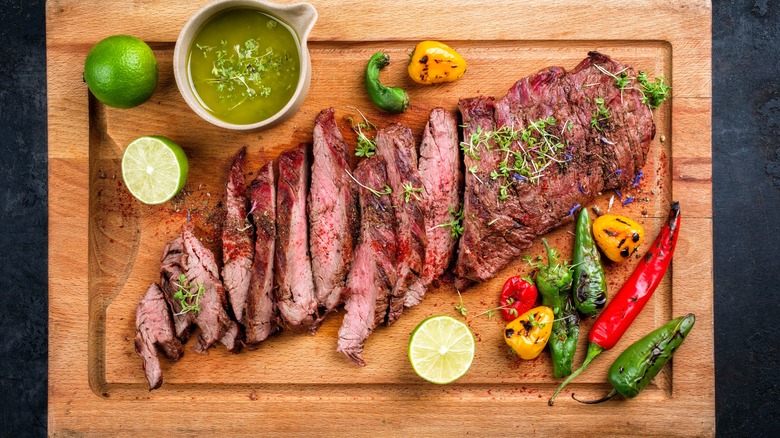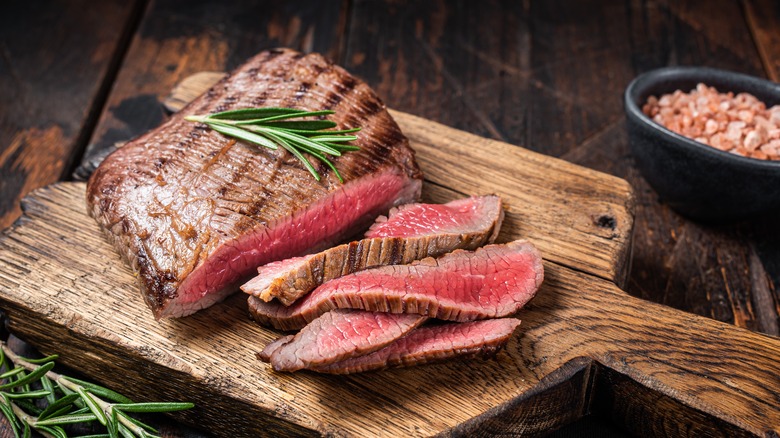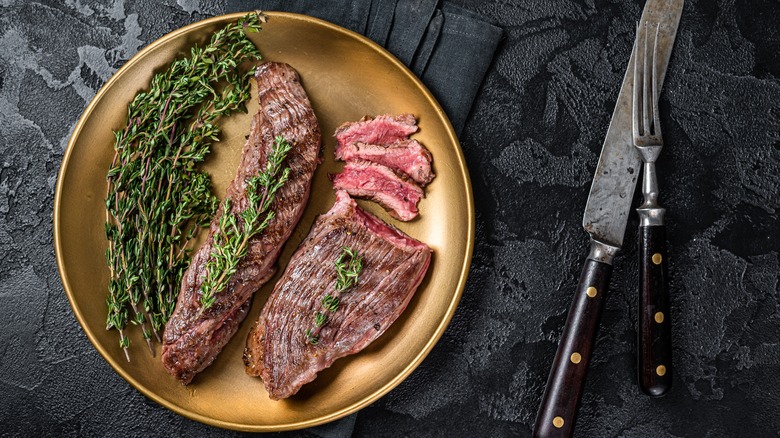What Bavette Steak Is Called In US Grocery Stores
Once a rare sight on butcher display shelves, bavette steak is becoming more popular among home cooks and steak enthusiasts. Previously a well-guarded secret among steak enthusiasts, the cut is now finally getting its due. The cut is long, flat, and great for grilling, marinating, and including in dishes ranging from fajitas to sandwiches. However, you would still be hard-pressed to find a "bavette" steak in grocery stores in the U.S. — but only because it's known by another name.
Bavette steak is most often called flap steak in the United States. Other common names for the cut include flap meat and sirloin flap, all of which pay tribute to the cut's flat, long nature, and the fact that it comes from the bottom flap of the sirloin. "Bavette" is a French word that means bib, because the cut resembles a baby's bib. This clothing-based name is similar to the popular skirt steak, which resembles the flap steak in its flat nature. So, the term flap steak is simply an English variation of the French name, both of which describe the flap-like nature of the steak cut.
A bib, not a skirt
Just because bavette steak resembles skirt steak does not mean that the two cuts are interchangeable. Many assume that bavette steak comes from the same region of the cow as skirt steak due to their similar appearance. However, this is not the case. While skirt steak comes from the underside of the cow, bavette steak is sourced from the sirloin, located in the middle of the cow's back. This difference is significant. Although the two steaks look similar, they have very different flavors and textures, and understanding what differentiates bavette from skirt steak can help you make better use of your steak.
One key difference between the two steaks is their texture. Bavette steak is more tender than skirt steak. In terms of flavor, skirt steak has a more robust, beefier taste compared to bavette steak. This makes bavette steak better for marinating, as it serves as a more suitable base for stronger flavors, and its tender texture makes it a great choice for sandwiches and other dishes. However, its less pronounced flavor doesn't mean bavette steak can't stand out on its own. Due to its marbling and relatively loose texture, it retains moisture well and remains juicy.
Best ways to cook your bavette steak
When cooking your bavette steak, or flap steak, there are a few tips to keep in mind to achieve the best result. Firstly, you'll want to cook this cut quickly, and at a high temperature. This is because bavette is a thin cut of steak that does not hold up well to slower cooking methods, which work best for thicker cuts. High temperatures are key to getting the best result, as they help to give your steak a good crust without overcooking the center.
You'll want to keep your bavette steak whole when cooking, ensuring not to cut it before cooking. This makes flipping the steak easier while cooking. And once you're done cooking, be sure to rest your steak before cutting; this helps to keep the meat as juicy as possible. When you do cut, remember to slice against the grain, as is recommended for many steaks. Keeping these tips in mind will help you achieve the best possible bavette, or flap steak. And once you've experienced a well-cooked cut of the steak, you won't be concerned with what it's called; you'll only remember its delicious flavor.


